In this article, I am bringing up a very real and increasingly voiced concern — especially among young men, students, and working professionals — about whether the current system, in the name of gender equality, is beginning to create gender imbalance in the other direction.
What is Gender Imbalance?
Gender imbalance means that one gender, usually men or women, is more present or has more opportunities than the other in a certain area. This can happen because of traditions, unfair rules, or how people see gender roles.
Example 1. In many technology companies, most of the workers are men, and women often get fewer chances to reach top positions.
Example 2. On the other hand, in fields like nursing or early childhood education, women are the majority, and men may face challenges or feel discouraged from joining these professions.
Let’s break this down honestly and without bias:
1. Disproportionate Schemes & Laws
- There are dozens of schemes, reservations, financial aids, and legal protections for women — sometimes even where they’re not necessarily disadvantaged (urban, educated women).
- Example: In competitive exams or entrepreneurship funds, women often get relaxations or quotas even if equally or more privileged than their male peers.
2. Lack of Support for General Category Men
- General category men, especially from middle-class or poor backgrounds, have almost no targeted schemes, despite struggling equally with:
- Unemployment
- Educational pressure
- Mental health
- Social expectations (earning, supporting family, etc.)
Read More: The First Time I Realized “Money is Everything”
3. Misuse of Gender-Focused Laws
- Laws like Section 498A (dowry harassment), Domestic Violence Act, and others are sometimes misused.
- Even the Supreme Court of India and Law Commission have acknowledged misuse, saying: “Many complaints under Section 498A are filed in the heat of the moment over trivial issues.”
4. No Talk of Men’s Mental Health, Rights, or Struggles
- Very few policies or public discussions center around male suicides, false allegations, custody rights, or domestic abuse against men.
- Suicide rate among men is much higher than women (as per NCRB).
So, Is This Reverse Discrimination or Reverse Gender Imbalance?
In some contexts — yes, it does feel like that.
- The intention of pro-women laws was to correct historical injustice.
- But when laws become one-sided and lack safeguards for the other side, they risk becoming tools of injustice themselves.
- That’s why balance, accountability, and data-based policy-making are necessary.
What’s Missing in Today’s System
For WomenFor MenLaws + schemes for safety, business, education, housing, etc. Very few targeted welfare programs, Special helplines, protection acts, No dedicated men’s helpline or commission, Financial aid & subsidies, No relaxation for general-category men in most schemes, Domestic violence protections, Men are not even recognized as victims legally
Why the Govt May Be Silent:
- Politics: Women-focused schemes are vote banks. Men are not a “vote group.”
- Social pressure: Speaking up for men is sometimes seen as “anti-women” due to the rising feminist narrative.
- Global trend: Many countries are seeing the same imbalance in the name of gender equality.
What Should Be Done to Stop Reverse Gender Imbalance
Reverse gender imbalance is not an official term, so there are no obvious resolutions from the government. But I am suggesting a few points that can control the discrimination towards men, which is greatly inclined to women only (which is of course very dangerous) –
- Create a National Men’s Commission (just like NCW).
- Gender-neutral laws — protect whoever is the victim, regardless of gender.
- Support general category men with career aid, mental health resources, and legal safeguards.
- Track and publish data on false cases, male suicides, and unemployment.
- Shift from “women vs men” to “individual rights vs injustice”.
While women’s empowerment is essential, men’s struggles are real too — especially those in general categories who often get overlooked.
A just society doesn’t promote one group by silencing or disadvantaging another — it uplifts everyone fairly.

